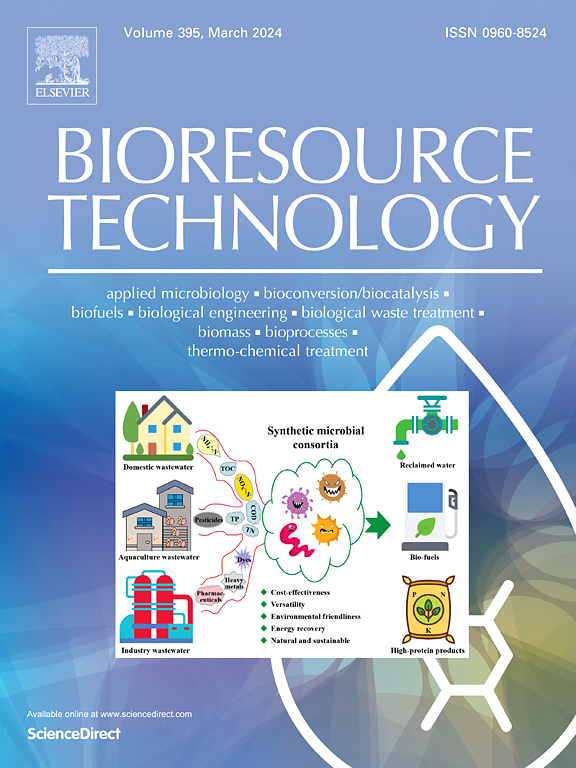评价腐殖质绿球藻生物质在纺织染料废水藻修复中的增值生化和生物柴油生产。
IF 9.7
1区 环境科学与生态学
Q1 AGRICULTURAL ENGINEERING
引用次数: 0
摘要
本研究探讨了腐殖质绿球藻(Chlorococcum humicolo)生物质在提取有价值的生物化学和生产生物柴油方面的潜力,重点研究了纺织染料废水的藻修复。在实验室用CFTRI培养基、复合染料出水和染料浴出水三种培养基培养藻类。在CFTRI培养基中,细胞数最高(254 × 104个细胞/ml),油含量最低(16.6 %),而复合染料废水的生物量最高(2.8 g/L干重(DW)),油含量最高(26 %)。染料浴出水产生的中间结果为2.0 g/L DW生物质和24% %含油量。生化分析表明,在高速率藻池(HRAP)染料浴出水中生长的藻类含有最高水平的脂质(45.00 mg/106细胞)、β-胡萝卜素(0.5683 µg/106细胞)、蛋白质(9.89 mg/106细胞)和叶绿素a(0.9890 µg/106细胞)。气相色谱-质谱分析表明,藻油的FAME谱中饱和脂肪酸的比例很高(高达94 %),使其成为生产生物柴油的理想选择。尽管其脂质含量较高,但在废水修复和生物燃料生产方面具有双重效益。本文章由计算机程序翻译,如有差异,请以英文原文为准。

Evaluating value-added biochemical and biodiesel production from Chlorococcum humicolo algal biomass in phycoremediation of textile dye effluents
This study investigates the potentials of Chlorococcum humicolo algal biomass for the extraction of valuable biochemical and biodiesel production, with focus on the phycoremediation of textile dye effluents. The alga was cultivated in three media: CFTRI medium, combined dye effluent, and dye bath effluent in the laboratory. The highest cell count (254 × 104 cells/ml) and lowest oil content (16.6 %) were observed in CFTRI medium, while the combined dye effluent yielded the highest biomass (2.8 g/L dry weight (DW)) and oil content (26 %). Dye bath effluent produced intermediate results with 2.0 g/L DW biomass and 24 % oil content. Biochemical analysis revealed that algae grown in dye bath effluent from High Rate Algal Pond (HRAP) contained the highest levels of lipids (45.00 mg/106 cells), β-carotene (0.5683 µg/106 cells), proteins (9.89 mg/106 cells), and chlorophyll ‘a’ (0.9890 µg/106 cells). GC–MS analysis of the algal oil’s FAME profile showed a high proportion (up to 94 %) of saturated fatty acids, making it an excellent candidate for biodiesel production. Despite its better lipid content, C. humicolo demonstrates dual benefits for wastewater remediation and biofuel generation.
求助全文
通过发布文献求助,成功后即可免费获取论文全文。
去求助
来源期刊

Bioresource Technology
工程技术-能源与燃料
CiteScore
20.80
自引率
19.30%
发文量
2013
审稿时长
12 days
期刊介绍:
Bioresource Technology publishes original articles, review articles, case studies, and short communications covering the fundamentals, applications, and management of bioresource technology. The journal seeks to advance and disseminate knowledge across various areas related to biomass, biological waste treatment, bioenergy, biotransformations, bioresource systems analysis, and associated conversion or production technologies.
Topics include:
• Biofuels: liquid and gaseous biofuels production, modeling and economics
• Bioprocesses and bioproducts: biocatalysis and fermentations
• Biomass and feedstocks utilization: bioconversion of agro-industrial residues
• Environmental protection: biological waste treatment
• Thermochemical conversion of biomass: combustion, pyrolysis, gasification, catalysis.
 求助内容:
求助内容: 应助结果提醒方式:
应助结果提醒方式:


